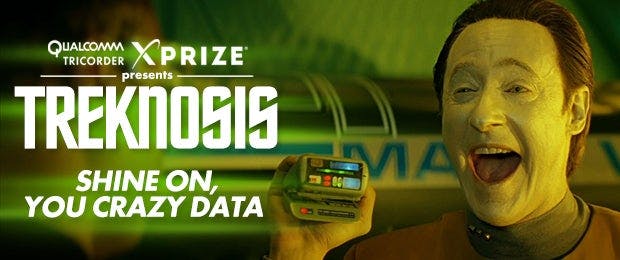Published Sep 29, 2014
Shine On, You Crazy Data
Shine On, You Crazy Data

I want to talk about Data for a second.
We all know Data has superhuman strength, but why doesn't he use it all the time? He could be down in the cargo bay moving barrels of quaratum around, or lifting shuttlecraft up so engineers could get access to their ventral thruster arrays. But no -- none of that. He's up on the bridge instead, sitting at Ops. In fact, the only times he ever seems to use the true extent of his android strength is in emergency situations while on away missions, moving obstacles or opening doors that would otherwise be impossible for his crewmates to budge. I don't think this is a coincidence, and it's not just a matter of TV special effects budgets, either. What's one of the main things we know about Data? He's always trying to be more human: learning how to tell jokes. Owning a cat. Growing a beard.

I think Data sticks to human-scale strength in order to appear more human, saving his mechanical muscle for when it's most needed in true life-or-death situations. What a guy! No such modesty in Harry Mudd’s androids, who were only too happy to demonstrate their superiority in all things except bad poetry, pantomime and silly dances.

It's funny then, that we're doing the converse by trying to augment our human strength using advanced technology. Take a look at this BBC video featuring a "body extender" built by Italian engineers at the Perceptual Robotics Laboratory (PERCRO) in Pisa. Look familiar? Anyone? Anyone?

One of the core uses PERCRO sees for a suit like this is in rescue applications, which is a superb -- and familiar -- idea.

Here on Earth, we might someday see relief workers searching for survivors in the rubble of a disastrous earthquake dressed in advanced body extenders, lifting tons of concrete and steel without the need for bulldozers or other conventional construction equipment.
All of this is great, but let's take a step back: if we're working on enhancing humans, why not look into helping them do everyday things? Can we build a suit that helps someone who's been rendered paraplegic to walk again? At that point, I think we cross the line from mere augmentation into true bionics. The difference: developing a way for our bodies to talk to enhanced or replacement limbs without having to press buttons.
How far away is that technology? Not as far as you think, it turns out. A device called the epidural stimulator is now in the trial phase that grants victims of spinal injury limited but impressive use of their lower bodies. It uses precision electrical stimulation of different areas of the spinal cord to initiate movements like standing, moving a leg, or flexing core muscles. For people who've been told they'll never walk again, this is a landmark breakthrough.
(Interestingly, something like this technique gets used in one of my very favorite Star Trek: Deep Space Nine episodes, "The Magnificent Ferengi." In a last-ditch effort to pull off a prisoner exchange, Nog uses a neural stimulator to essentially shock different parts of a dead Vorta's brain into twitching his body's muscles, making him "walk" down a corridor in one of the most memorable, and macabre, scenes of the series, especially for an episode where Iggy Pop guest-starred.)

The epidural stimulator is just one of the fantastic first steps we've taken down the road to true bionics, relying as it does on a handheld control to initiate movements. The next level: ditching the remote entirely and using nerve impulses directly from the body itself to control a piece of technology. We're getting there, too: the FDA approved the DEKA Arm will be for sale to the general public in May. The DEKA Arm reads signals from the wearer's muscles and responds with an array of 10 different movements, including moves that are impossible with current hook-style prosthetics. Nice!
What's the next step, you may ask? It just so happens we here at XPRIZE have a bionics-related XPRIZE competition concept on the table, which could inspire the creation of innovations and enhancements currently believed to be impossible, or even things nobody's thought of yet. We may be looking at the start of a future where enhanced humans are commonplace, showing off super strength, speed, and stamina in everyday life. When we finally get around to making an android like Data, maybe he won't need to hide his abilities in order to feel like he fits in.--
Jon Sung is a contributing writer for XPRIZE and copywriting gun-for-hire to startups and ventures all over the San Francisco Bay area. When not wrangling words for business or pleasure, he serves as the first officer of the USS Loma Prieta, the hardest-partying Star Trek fan club in San Francisco.
XPRIZE is an innovation engine. We design and operate prize competitions to address global crises and market failures, and incentivize teams around the world to solve them. Currently, we are operating numerous prizes, including the $30M Google Lunar XPRIZE, challenging privately funded teams to successfully land a robot on the Moon’s surface, and the $10M Qualcomm Tricorder XPRIZE, challenging teams around the world to create a portable, wireless, Star Trek-inspired medical device that allows you to monitor your health and medical conditions anywhere, anytime. The result? Radical innovation that will help us all live long and prosper.
Sign up today to join our mission, be a part of our campaign and win collectibles at: tricorderfederation.org.





